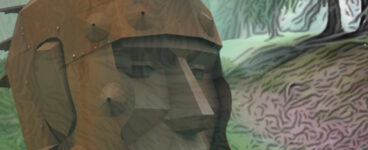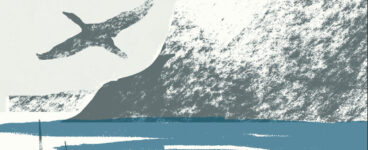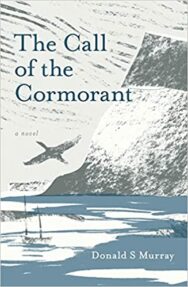‘When the man had made up his mind, no surge of the sea could stir or shift him.’
Based on a true story, The Call of the Cormorant centres Karl Kjerúlf Einarsson – artist, adventurer, charlatan and swindler, forever in search of Atlantis. This ‘unreliable biography’ is a fantastical tale of island life and adventure, intersecting with his arrival in 1930s Berlin. You can read an extract below.
The Call of the Cormorant
By Donald S Murray
Published by Saraband Books
A storm was coming.
We could see the clouds darkening over the unfamiliar shores of North Rona a short distance away, layer upon layer stacking up from the horizon they had long been stored behind, becoming dense and impenetrable, the wind, too, chilling. I shivered, regretting the decision that had taken us this far north. There had been too few fish to be caught in the narrow waters of the Minch over the last while, between the northern end of Skye and Harris. We knew this only too well. We had cast our lines there for weeks, only to lift them empty. It was this that had brought us this far away from our homes in Scalpay. Desperation. Need. Hunger.
A storm was coming.
When it arrived, it was likely to be at its most intense in the waters where we were now. Under the ocean’s surface, a narrow ridge of rock stretches from Ness, at the top of Lewis, all the way to North Rona. There is a shallowness of water here, a space into which the Atlantic tumbles whenever sky and sea churn, as they seemed likely to do at that moment. When I saw the signs, the gathering of clouds, the increasing spit and fury of the wind, I turned to my fellow crewman Norman Macleod.
‘Shall we head for Rona? Tie up there?’
‘I don’t think we need to. It’ll quickly blow over.’
‘What about Skigersta or Cape Wrath?’ I suggested, mentioning places at the northern edge of Lewis and Sutherland. There are harbours in those locations, places where we could tie up safely.
‘I don’t think so, Iain. It would be crazy to come all this way just to turn around again, simply for the sake of a squall. Besides, those places aren’t exactly the most sheltered of harbours. As risky in their own way as being out here. Let’s sit it out.’
I nodded reluctantly. There was truth in what Norman was saying. I had heard of boats going down near the Kyle of Durness or Loch Eriboll, one from Scalpay sinking near Tolsta Head. Those parts were almost as dangerous as here. Yet, despite his argument, this place was probably the riskiest of all. On a stormy day, the depths of the Atlantic could come storming like an army over that stony border between sea and land. We should really turn the boat round and head for Rona, tie up there for a day or two to allow the ocean to become still and peaceful again. I had heard accounts of boats from these parts – fishing, say, off Sule Stack and Sule Skerry – being driven towards Norway or the Faroe Islands, ending up wrecked on the coast of Europe. But I knew better than to argue with Norman about that. When the man had made up his mind, no surge of the sea could stir or shift him.
‘We’ll ride it out,’ I heard him mutter. ‘It won’t be long passing.’ And then, almost as an afterthought, ‘Take the sail down. We don’t want things to be too easy for the storm.’
It was just after that when the storm began – wind and wave combining to bludgeon the deck, washing over it with a thunderous weight of water. I gripped the side of the boat tightly, aware that the force of the sea threatened to sweep me away from my place. The thought began to occur to me that I might never see Scalpay again; the placenames of the island – Ceann a’Bhaigh, Rubha Glas, Meall Chailbost – coming from my lips like a prayer. I could see some of the sights too, streaming through my head with the suddenness of the lash of surf that crested each swell. The cattle. Sheep. Heather. Sand. As soon as they came to me, I had the thought that they were a presentiment of death, a sign that I wasn’t going to come across those places anymore. I stiffened and tried to chase the thought from his head. There was no need to think like that.
No need to think like that when the boat was breached, water lapping across the deck. No need to think like that even when I saw Norman toppling into the sea a short time later. No need to think like that even when the mast was broken, shattered in half by the waves. No need to think that even when the storm continued for hours, over days and nights, till the moment I looked up to see that our vessel was a short distance away from another group of islands; when I became aware, too, that there was another boat making its way towards us from there; when I was conscious, too, that only one of the others who had gone out fishing from Scalpay a few days before with me was still on board our boat, still showing signs of life.
The Call of the Cormorant by Donald S Murray is published by Saraband Books, priced £9.99.
ALSO IN THIS ISSUE

 Walking the Antonine Wall
Walking the Antonine Wall
Having decided to walk the Antonine Wall from east to west, I was immediately faced with an importan …

 The Call of the Cormorant
The Call of the Cormorant
‘When the man had made up his mind, no surge of the sea could stir or shift him.’













